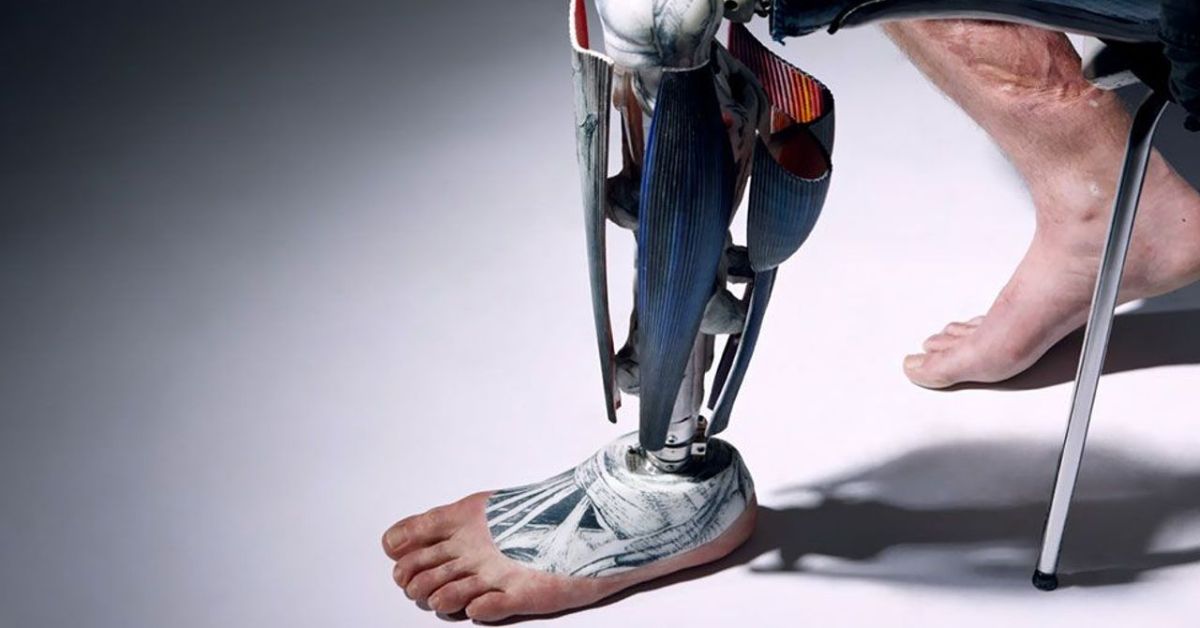Future of Prosthetic Limbs
Like everyone in New England’s close-knit climbing community, Jim Ewing knew all about Hugh Herr, the young man who lost both legs below the knee to a 1982 Mount Washington ascent that killed one of his climbing partners. Herr not only returned to climbing, but he created bionic limbs that pushed the possibilities of the future of prosthetic limbs.
Ewing and Herr even shared a “roach-infested cabin” as college-aged climbers working in North Conway, N.H., for few summers. But neither imagined the fateful way their lives would intersect again 30 years later. Ewing is poised to become the first recipient of a future brain controlled limb designed by Herr’s team at the MIT Media Lab. He lost one of his own feet to a climbing accident at the age of 51.
That would make Ewing a double pioneer. Four months ago he underwent first-of-its-kind amputation surgery at Brigham and Women’s Faulkner Hospital to prepare him for the special prosthesis.
Already a Pioneer
Dr. Matthew Carty — who developed the surgery at Brigham, in collaboration with Herr’s group — laced together tendons at the end of Ewing’s shortened leg to preserve delicate neurological connections.
So instead of the phantom, haywire signals other amputees often feel — the sensation that their surgically removed foot has grown larger, say, or is bent behind their knee — Ewing can tense and relax the muscles in his lower leg in harmony. So it feels like his old foot is there, moving as always. And when the MIT team attaches sensors to Ewing’s leg, they can see the signals between his brain and the specific leg muscles needed to move ankle and foot.
Future of Prosthetic Limbs
In the coming year, the surgeons hope to embed wireless versions of those sensors and prepare Ewing for a prototype of a prosthetic ankle and foot he will be able to control with his brain, without looking at it. On Monday, Ewing and the team celebrated his success so far in recovering from a procedure newly dubbed “The Ewing Amputation” — and made possible by an endowment seeded by the family of a Boston Marathon bombing survivor treated at the Brigham, whose donation accelerated the research.
Dr. Matthew Carty spoke at a news conference.
Though prosthetic devices have advanced dramatically in recent decades — from wood and metal to carbon fiber and microprocessors — amputation surgery has remained “largely unchanged for over 2,000 years,” said Carty, director of the Brigham’s lower-limb transplant program.
Brining the Clinical and Technological Sides Together
Historically, doctors on the clinical side of amputation treatment rarely spoke with researchers on the technological side. In 2012, Carty’s team at the Brigham began collaborating with Herr’s MIT group to devise an amputation surgery that could prepare a limb for a brain-controlled prosthetic.
Two years later, Carty’s group received the first $100,000 grant from an endowment known as the Gillian Reny Stepping Strong Fund. That paid for expenses like an operating microscope and simulation surgery on cadavers. These items helped speed the path to surgery on a pioneering patient.
Ewing, meanwhile, had kept up with Herr from afar while devoting much of his life to climbing, as a rope engineer for a Maine-based manufacturer of climbing equipment.
In December 2014 Ewing was climbing with 13-year-old daughter Maxine in the Cayman Islands when a technical failure caused him to drop 50 feet, crashing onto a bed of sharp rock. The impact fractured his wrist and pelvis, dislocated his shoulder, and separated ribs from his sternum. But it was a shattered ankle and nerve damage that would ultimately cause the most pain. Despite multiple surgeries Ewing was unable to walk 100 feet without collapsing in agony. “Even the smallest grain of sand would cause sharp stabs of pain up through my foot,” Ewing said.
He was plotting a grueling, uncertain surgical course when he reconnected last winter with Herr. Herr told him about his latest research and sent him to see Carty. They hit it off, both men sharing a Maine sensibility. Ewing was impressed with Carty’s patient listening, the first surgeon he met who didn’t have “his hand on the doorknob, ready to leave before you’re done asking questions.”
Pain Relief and Mobility
They spent the first half of 2016 determining that continued salvage would not bring Ewing the pain relief and mobility he craved, before scheduling surgery. At a pre-Thanksgiving gathering Monday, they celebrated his recovery so far. (Herr was traveling and not immediately available for an interview.)
“He has demonstrated movement abilities and perceptions far beyond what we typically witness in patients with standard amputations,” Carty said. “We believe that Jim’s progress will allow us to reframe the way we think about limb loss.
“Traditionally, amputation has often been seen as a failure, the surgical equivalent of throwing in the towel to the ravages of trauma, disease, or just plain bad luck. By reinventing the way that amputations are performed, we hope to elevate them to another form of limb salvage, one designed to restore as much function as possible.”
Ewing, who is already hiking again in a traditional prosthesis while awaiting surgery to embed the sensors for the prototype, said he is thankful to be a pioneer, if slightly sheepish about “The Ewing Amputation.”
Future of Prosthetic Limbs
“I’m not sure how I feel about having my name attached to my ability to lose body parts,” he said. “But it’s actually quite an honor, considering that so many other people had so much more to do with the conception of this, the planning of this, and actually carrying it out. I’m just the guy that smashed himself to pieces. And the timing was just right.”
https://www.bostonglobe.com/metro/2016/11/21/the-prosthetic-future/Ld6C2rxZL4uiotc96kNyPO/story.html





